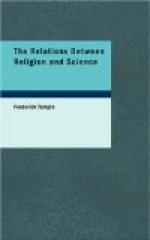Now it is this assumption which must be first examined. What is its source? What is its justification? What, if any, are its limits?
It is not an assumption that belongs to Science only. It is in some form or other at the bottom of all our daily life. We eat our food on the assumption that it will nourish us to-day as it nourished us yesterday. We deal with our neighbours in the belief that we may safely trust those now whom we have trusted and safely trusted heretofore. We never take a journey without assuming that wood and iron will hold a carriage together, that wheels will roll upon axles, that steam will expand and drive the piston of an engine, that porters and stokers and engine-drivers will do their accustomed duties. Our crops are sown in the belief that the earth will work its usual chemistry, that heat and light and rain will come in their turn and have their usual effects, and the harvest will be ready for our gathering in the autumn. Look on while a man is tried for his life before a jury. Every tittle of the evidence is valued both by the judge and jury according to its agreement or disagreement with what we believe to be the laws of Nature, and if a witness asserts that something happened which, as far as we know, never happened at any other time since the world began, we set his evidence aside as incredible. And the prisoner is condemned if the facts before us, interpreted on the assumption that the ordinary laws of Nature have held their course, appear to prove his guilt.
What right have we to make such an assumption as this?
The question was first clearly put by Hume, and was handled by him with singular lucidity; but his answer, though very near the truth, was not so expressed as to set the question at rest.
The main relation in which the uniformity of Nature is observed is that of cause and effect. Hume examines this and maintains that there is absolutely nothing contained in it but the notion of invariable sequence. Two phenomena are invariably found connected together; the prior is spoken of as the cause, the posterior as the effect. But there is absolutely nothing in the former to define its relation to the latter, except that when the former is observed the latter, as far as we know, invariably follows. A ball hits another ball of equal size, both being free to move. There is nothing by which prior to experience we can determine what will happen next. It is just as conceivable that the moving ball should come back or should come to rest, as that the ball hitherto at rest should begin to move. A magnet fastened to a piece of wood is floating on water. Another magnet held in the hand is brought very near one of its poles or ends. If two north poles are thus brought together the floating magnet is repelled; if a north and a south pole are brought together the floating magnet is attracted. The motion of the floating magnet is in each case called the effect; the approach of the magnet held in the hand is called the cause. And this cause is, as far as we know, invariably followed by this effect. But to say that one is cause and the other effect is merely to say that one is always followed by the other; and no other meaning, according to Hume, can be attached to the words cause and effect.




